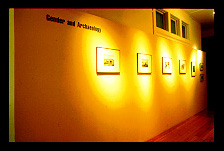![]()
 |
 |
The study of ancient civilizations does not exist in a vacuum of "pure" scholarship but is instead as much a product of its environment as the ancient cultures that are the object of study. Egyptology, without question, has been profoundly affected by societal norms concerning gender; although women involved with Egyptology have been numerous and have made valuable contributions, they rarely received the kind of recognition or professional advancement that their male colleagues did. The University of Michigan has a special history with respect to the involvement of women in archaeology and the study of ancient Egypt, a history closely connected with Michigan's ambitious excavation of the Egyptian site of Karanis. This eleven-year endeavor (1924-35), with study seasons at Soknopaiou Nesos and Terenouthis, called on a wide range of expertise among the University of Michigan community and beyond. Women were active both in the field and back in Ann Arbor.
In more recent years, new generations of women have continued to make substantial contributions to the study of the material from Karanis, both in the context of museum exhibitions and in the cataloguing and analysis of specific corpora of material from the excavations. At present, women are involved in ongoing research on Karanis and related sites at Michigan, including the efforts to make materials from the University of Michigan excavations available in the World Wide Web. At present, the Kelsey Museum of Archaeology is predominantly staffed by women, who, by contributing to the mission of the Kelsey Museum to preserve, interpret, exhibit, and publish its collections in a variety of ways, are following in the footsteps of the first generation of women involved in the study of ancient Egypt at the University of Michigan.
Go to images of:
| The University of Michigan Karanis Expedition |
![]()